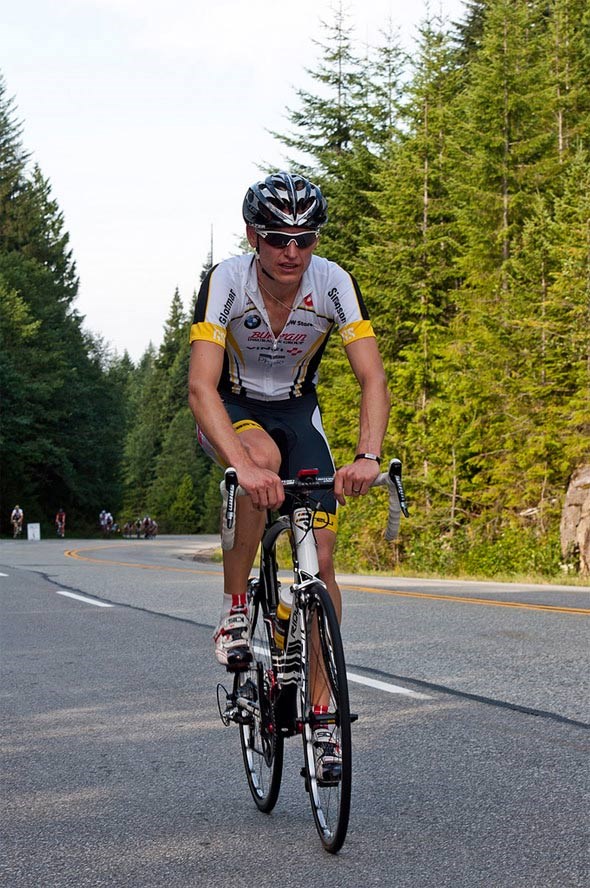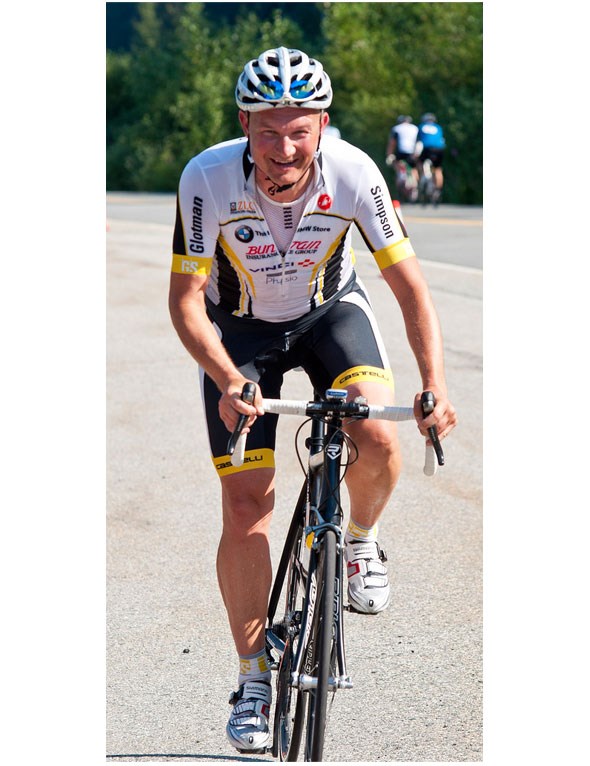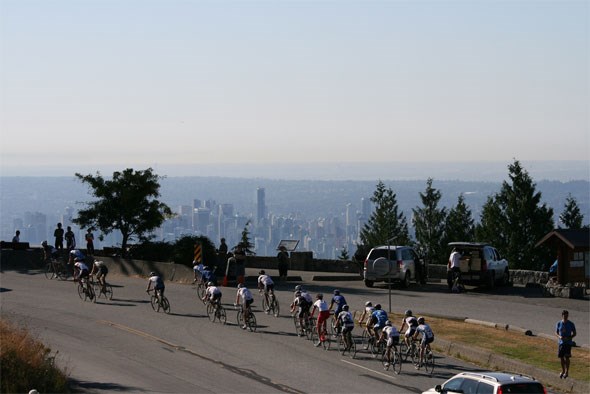By Allan Prazky. Glotman•Simpson Cycling Club
You don’t need to ride in the Tour de France to encounter to some good size hills. Hundreds of local cyclists go tackle our local mountains every year. You may already be signed up for a great hill climb event such as the Glotman•Simpson Cypress Challenge. Or, you may be thinking you would love to challenge yourself but could really use some tips on getting up the hill.
Never fear, we are here to help you make that Mountain into a molehill.
Climbing Techniques
Generally speaking, hill climbing takes two forms, seated climbing and out of saddle climbing, though to climb a mole hill (or a mountain) quickly, a rider will likely employ a mix of both techniques.

Grinding out a seated climb! Photo: Scott Robarts
On longer, shallower climbs (less than 5 or 6%), stay in the saddle and keep a relatively high cadence Seated climbing will allow a rider to burn less energy and facilitates the use of larger glute (butt) and hip muscles - about 75–85rpm. Maintaining a quick, efficient leg speed is particularly important for heavier riders.
To maximize efficiency, and to gain a leverage advantage, slide back on your seat, allowing the nose of your saddle to peek through your legs. Instead of pushing directly down on the pedals in a piston-like fashion, sliding back on the saddle allows you to push down and forward on the pedals. Remember – relax your grip on the bars, but use the bars as a fixed point to push and pull against. On longer climbs, get out of the saddle occasionally, allowing brief bouts of recovery for your back (ouch!) and butt, varying the muscle groups that are producing the motive force.
Out of the saddle efforts add instant power to the pedal stroke for hard efforts, accelerations (think of reacting to a sudden increase in speed) or climbing steep hills at the expense of increased energy requirements - about 10% more - over a seated counterpart.

Up and out of the saddle in an attacking style! Photo: Scott Robarts
With proper out of the saddle ‘rocking’ technique, cyclists can conquer all but the steepest of hills by Done properly, out of the saddle climbing looks like this: With your hands holding the brake hoods, get out of the saddle and pull with the right arm (recruiting the assistance of biceps and lats), as the left leg pushes down on the power stroke. As you shift your weight from right to left, pull on the bars as you push with the left leg. On steep grades, it is almost as if you were walking up the hill. The bike will have a natural sway from side to side as your body weight is shifted – don’t fight this! It’s okay for the bike to rock back and forth in a controlled motion. Advanced riders might even perform a very tight arcing S pattern with their front wheel as they wind their way up the road, using their body weight and upper body strength to assist the power of their legs.
Rules to Live By

Relax. Don’t waste energy with a death grip on the bars. Relax your grip and your upper body. As you climb in a seated position, remember to keep your hands on the top of the bars, close to the stem, allowing for maximum diaphragm movement, maximizing your ability to breathe deeply.
When it comes time to stand, it's best to position the hands on the hoods for maximum stability. Unless you’re sprinting to victory on a mountain-top finish, you should never find yourself climbing in the drops; the hunched over position constricts breathing rates, and generally makes life miserable as the road winds to the sky.
Keep forward momentum! Once you enter a hill, it’s critical to keep the momentum going! If you become over-geared or ‘bogged down’ in a particular gear mid-hill, accelerating back to your climbing speed is both difficult and taxing - bringing you further in to the dreaded red zone. Instead, stay on top of your gear, aiming for a cadence on either side of 80rpm. If you find your cadence slowing, shift into an easier gear immediately, and try to recapture the lost momentum with a quick out of the saddle burst.
Learn to Love the Hills. Hills can (and should be added) to any training regime. Ideally, a visit to the mountains (or any incline) would be included on a weekly or every 10 to 14 day basis. Find a hill that you can climb in a seated position (3 to 6%), with a length of about 4 to about 10 minutes (longer is better for more advanced cyclists). Start with two or three seated hill repeats, and add intervals as you gain fitness. An important factor in hill climbing is consistency. If you aim for 3 intervals, the first repeat should fall within 10% of the total time of your last. Recovery is the route back to the start area, with an added dogleg if increased recovery is required. Be careful not to crack-off a phenomenally quick first climb, only to climb the last hill at a turtles pace. Be consistent! Keeping a log of times is good, and also serves to motivate and monitor performance.
Accelerations. As you progress and gain fitness, introduce accelerations to your hill repeats. On longer hills that are reasonably steep, accelerate hard (or in business terms ‘jump’) from a moderate pace, holding the accelerated pace for a defined period – 30s, 45s or up to 120s. From the accelerate speed, sit back down and resume your normal climbing pace for three or four minutes, then jump again! The key to this workout is hard, maximal efforts, followed by moderate load, repeated. Ouch.
Playing the piano. How do you become a better climber? The absolutely best way to improve climbing is to – SURPRISE – start climbing! Find a variety of hills; long, short, shallow steep, and introduce a steady diet of hills into your regular riding.
Put our tips into action and register for the 6th Annual Glotman•Simpson Cypress Challenge in support of pancreatic cancer research on August 17th. Hundreds of cyclists will challenge themselves to ride 5 or 12km up Cypress with 100% of proceeds benefitting the BC Cancer Foundation’s new Pancreas Centre BC. Individual registration is by suggested minimum donation of $25 or $40 after August 9th.
All you need is a properly maintained bike, a helmet and the determination to climb Cypress.
Learn more at glotmansimpsoncycling.ca/cypress-challenge


